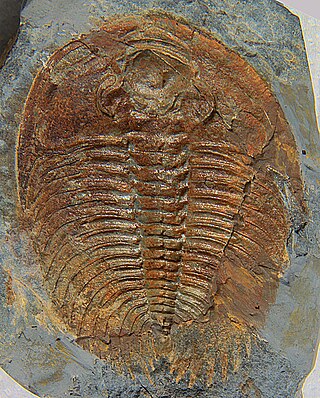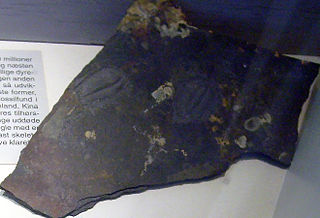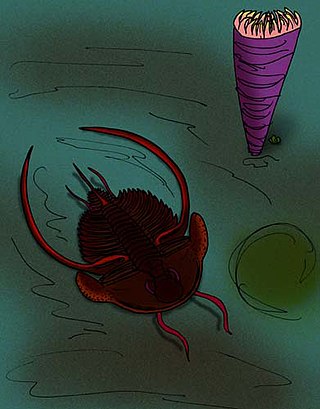
Redlichiida is an order of trilobites, a group of extinct marine arthropods. Species assigned to the order Redlichiida are among the first trilobites to appear in the fossil record, about halfway during the Lower Cambrian. Due to the difficulty to relate sediments in different areas, there remains some discussion, but among the earliest are Fallotaspis, and Lemdadella, both belonging to this order. The first representatives of the orders Corynexochida and Ptychopariida also appear very early on and may prove to be even earlier than any redlichiid species. In terms of anatomical comparison, the earliest redlichiid species are probably ancestral to all other trilobite orders and share many primitive characters. The last redlichiid trilobites died out before the end of the Middle Cambrian.

Nevadia is an extinct genus of redlichiid trilobites, with species of average size. It lived during the Atdabanian stage, which lasted from 530 to 524 million years ago, in what are today Western Canada, the Western United States, and Mexico.

Wanneria is an extinct genus from a well-known class of fossil marine arthropods, the trilobites. It lived during the later part of the Botomian stage, which lasted from approximately 524 to 518.5 million years ago. This faunal stage was part of the Cambrian Period. Wanneria walcottana is the only known species in this genus.
Elliptocephala is an extinct genus from a well-known class of fossil marine arthropods, the trilobites. It lived from the later part of the Tommotian to the upper Botomian. Elliptocephala can easily be confused with Ellipsocephalus, a trilobite genus of the Ptychopariida order.

Archaeaspis is an extinct genus of redlichiid trilobites. It lived during the late Atdabanian stage, which lasted from 521 to 514 million years ago during the early part of the Cambrian Period. The first specimens were first found in Siberia, where they were originally thought to have been endemic. Later, though, more specimen were found in the Inyo Mountains in Southern California. An Ediacarian proarticulatan was given the same name, Archaeaspis Ivantsov, 2001. This is however a junior homonym. The name Archaeaspis Repina in Khomentovskii and Repina, 1965, for the trilobite has priority. The new valid name for the proarticulate is Archaeaspinus Ivantsov, 2007.

Buenellus higginsi is an average size trilobite, which lived during the Lower Cambrian period, in what is now North-West Greenland. It is a prominent member of the Sirius Passet fauna. Buenellus higginsi is the only known species in the genus Buenellus.

Callavia is an extinct, monotypic genus of trilobite arthropods. C. broegeri lived during the late Atdabanian stage, which lasted from 530 to 524 million years ago during the early part of the Cambrian Period in what are today Canada and the United States.
Cirquella is an extinct genus from a well-known class of fossil marine arthropods, the trilobites. It lived during the Atdabanian stage, in the former continent Laurentia.

Yunnanocephalus is a genus of ptychopariid trilobite. It lived during the late Atdabanian and Botomian stages, in what are currently Antarctica, Australia and China. It was a "moderately common" member of the Chengjiang Fauna. Yunnanocephalus is the only genus currently assigned to the Yunnanocephalidae family.

Nephrolenellus is an extinct genus of trilobite, fossil marine arthropods, of relatively small size. Currently two species are attributed to it. Nephrolenellus lived at the end of the Lower Cambrian. Species are known from the Great Basin of California, Nevada and Arizona, with one specimen from Canada.

Mesonacis is an extinct genus of trilobite that lived during the Botomian, found in North-America, and the United Kingdom. Some of the species now regarded part of Mesonacis, have previously been assigned to Angustolenellus or Olenellus (Angustolenellus). Angustolenellus is now regarded a junior synonym of Mesonacis.

Fallotaspis is a genus of redlichiid trilobites found in Early Cambrian-aged strata of the United States and Morocco.

Holmiidae is a family of trilobites, that lived during the Lower Cambrian (Atdabanian). The Holmiidae is a diverse family of eight genera containing at least 17 species. It includes some of the earliest trilobites of Baltica. Holmiidae occur throughout Baltica and Western Laurentia, and also in Morocco.

Peachella is an extinct genus of trilobites, fossil marine arthropods, with species of average size. It lived during the Toyonian stage, 516 to 513 million years ago, in what is today the southwestern United States. It can easily be distinguished from other trilobites by its club-like genal spines.

The Olenelloidea are a superfamily of trilobites, a group of extinct marine arthropods. They lived during the late Lower Cambrian and species occurred on all paleocontinents.
Mesolenellus is an extinct genus of trilobites that lived during the lower Cambrian (Botomian), found in Greenland and Spitsbergen.

The Bristoliinae is an extinct subfamily of trilobites, fossil marine arthropods, with species of small to average size. Species belonging to this subfamily lived during the Botomian and Toyonian stage (Olenellus-zone), 522-513 million years ago, in the former continent of Laurentia, including what are today Mexico, the Appalachian Mountains and the south-western United States, and Canada.

Bristolia is an extinct genus of trilobite, fossil marine arthropods, with eight or more small to average size species. It is common in and limited to the Lower Cambrian shelf deposits across the southwestern US, which constitutes part of the former paleocontinent of Laurentia.
Bolbolenellus is an extinct genus of trilobites, fossil marine arthropods, with five species attributed to it currently. It can be easily distinguished from all other trilobites by the combination of the absence of dorsal sutures in the head shield like all Olenellina, and a distinctly bulbous frontal lobe (L4) of the raised axial area in the head called glabella. The species lived at the end of the Lower Cambrian.

The ”Fallotaspidoidea” are a superfamily of trilobites, a group of extinct marine arthropods. It lived during the Lower Cambrian (Atdabanian) and species occurred on all paleocontinents except for the Gondwana heartland. A member of this group, Profallotaspis jakutensis, has long been the earliest known trilobite, but recently the redlichiid Lemdadella has been claimed as occurring even earlier.














